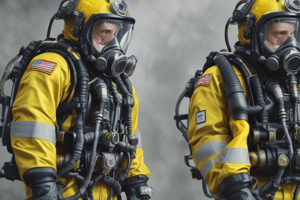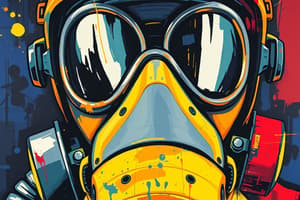Podcast
Questions and Answers
What is the primary function of the mask-mounted G1 Regulator?
What is the primary function of the mask-mounted G1 Regulator?
To maintain positive pressure in the facepiece while providing breathable air to the user.
How does the bypass valve of the G1 Regulator function?
How does the bypass valve of the G1 Regulator function?
It offers variable flow up to 120 liters when fully opened.
What pressure does the G1 Pressure Reducer allow the SCBA to achieve?
What pressure does the G1 Pressure Reducer allow the SCBA to achieve?
It reduces the cylinder pressure to an intermediate pressure of 115 PSI.
What safety mechanism does the pressure reducer incorporate?
What safety mechanism does the pressure reducer incorporate?
What information does the G1 Heads-Up Display (HUD) provide?
What information does the G1 Heads-Up Display (HUD) provide?
What components make up the MSA G1 SCBA?
What components make up the MSA G1 SCBA?
How does the facepiece prevent lens fogging?
How does the facepiece prevent lens fogging?
What are the temperature and time specifications for the SCBA facepiece's heat protection?
What are the temperature and time specifications for the SCBA facepiece's heat protection?
What purpose does the mechanical speech diaphragm serve in the facepiece?
What purpose does the mechanical speech diaphragm serve in the facepiece?
What safety regulations does the MSA G1 SCBA comply with?
What safety regulations does the MSA G1 SCBA comply with?
Flashcards are hidden until you start studying
Study Notes
MSA G1 SCBA Overview
- Delivers breathable air from a compressed air cylinder through a pressure reducer, regulator, and facepiece.
- Exhaled air is released into the environment.
- Complies with NIOSH regulations under 42 CFR Part 84 and NFPA standards for emergency services.
SCBA Components
- Operates independently in dangerous atmospheres as a pressure-demand self-contained breathing apparatus.
- Facepiece includes inhalation valve to minimize fogging, nosecup, and exhalation valve.
- Features a mechanical speech diaphragm for improved communication and heat protection compliant with NFPA for 500° F for up to 5 minutes.
Regulator
- Known as the Demand Valve, maintains positive pressure in the facepiece.
- Reduces pressure further for breathable air, activated by inhalation with a minimum flow of 350 LPM.
- Bypass valve allows variable flow up to 120 liters, includes functionality for Heads-Up Display (HUD) and voice communications.
Heads-Up Display (HUD)
- Integrated HUD projects cylinder pressure and alarm status, utilizing 7 LED lights for better visibility.
Pressure Reducer
- Reduces cylinder pressure to 115 PSI, ensuring airflow even if a malfunction occurs.
- Includes a low-pressure warning bell that activates at 35% of rated service pressure.
Carrier and Harness Assembly
- Ergonomic backplate houses crucial components, including power module and pressure reducer.
- Features adjustable parts (shoulder pads, lumbar pad) for user comfort and enhanced visibility with retroreflective materials.
- Cylinder band provides security and stability during use.
Cylinder Specifications
- Utilizes low-profile Eclipse cylinder identifiable by its black color.
- Requires routine inspections, including visual checks for damage and functionality tests.
SCBA Inspection Protocols
- Visual inspections cover deterioration, tears, and signs of damage across all components.
- Functional tests must be performed to ensure operational integrity; any failure necessitates removal from service.
- Specific focus on facepiece integrity, regulator cleanliness, pressure reducer functionality, and cylinder pressure visibility.
Maintenance Checks
- Facepiece checks for lens integrity, rubber seal tightness, and proper valve function.
- Regulator checks for moisture, debris, and the condition of seals and quick connect fittings.
- Pressure reducer and cylinder checks include ensuring secure fittings and proper alignment of critical components.
- Regular assurance of power module and battery module connectivity is necessary for optimal functionality.
Studying That Suits You
Use AI to generate personalized quizzes and flashcards to suit your learning preferences.




